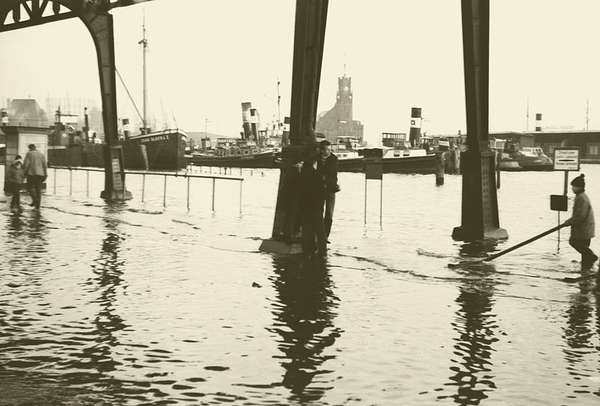Flooded… Catastrophic influences on genealogy
- 28. February 2017 - Archives, Societies, Museums, Germany, Hamburg, Historical Events, Historical Documents, General
In the night of 16 to 17 February 1962 the hurricane Vinicinette caused a storm flood at the North Sea coast of Germany. Hamburg was affected especially hard, the early warning systems failed and the danger wasn’t taken seriously. The residents of Hamburg were surprised by the water in their sleep. 315 people died in the city alone (of 340 people in total).
Documents that might have helped genealogists today were destroyed as well. The public record office itself was left unharmed, but the records of some administrative bodies were affected. It’s hard to estimate, how many records of private companies were lost as well. If one of your ancestors worked in any of those affected companies prior to 1962, it might be hard to find information today.
This storm flood wasn’t the first or the last nature or human caused catastrophe that troubles genealogy in Germany. Just think about the Second World War, the Thirty Years' War, the great fire in Hamburg in 1842 or the collapse of the historical archive in Cologne 2009. In 1997, the flood of the Oder further complicated the already challenging source material situation for Silesia after the Second World War.
Flood of data and writing errors – Disaster control via duplication
No wonder, efforts are made to protect records from destruction. Unfortunately it is not possible to secure original records against every danger. Therefore today a very important safety measure is digitalization. It also helps to easily access the data. But it isn’t without challenges, the sheer amount of historic records is overwhelming and there are high requirements for long-term readability. If you still have old diskettes (or even floppy disks or datasettes), you know how hard it can be to access the data. May it be due to unavailable reading devices, damaged memory or old file formats.
But making copies of records isn’t a new development. The genealogically very important church books were often copied by hand annually since 18th century (so-called duplicates). This was meant for control and as federal source as well as for protection against fire, war and other catastrophes. While this is great for today’s research, the duplicates are challenging in themselves. As they are written by hand, there are often differences between duplicates and original church books. Unreadable handwritings and inattention are only part of the problem. Often there is less information and detail in the copies, but interestingly sometimes it’s the other way around. A relatively small problem is the varying scale of handwriting, leading to shifts in pagination. If a duplicate is cited but an original church book consulted, this may cause problems. Therefore it’s extremely important to always note which source was used.
Of course as genealogists we are thankful for every duplicate. They are often the only source that allows us to retrace birth, marriage and death of a person. And without question, our work has become easier with digitalization. But to work with the original is still special.


0 comments